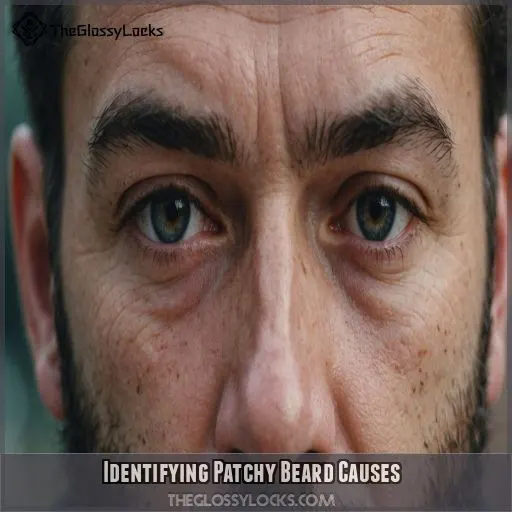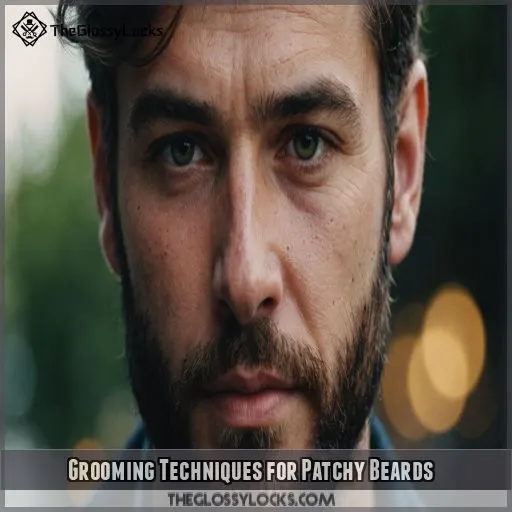This site is supported by our readers. We may earn a commission, at no cost to you, if you purchase through links.
 Don’t let those pesky beard patches get you down! With a few clever grooming tricks up your sleeve, you can fill in those gaps and rock a fuller, more impressive beard.
Don’t let those pesky beard patches get you down! With a few clever grooming tricks up your sleeve, you can fill in those gaps and rock a fuller, more impressive beard.
First, try strategic trimming and blending techniques to seamlessly conceal the sparse areas.
Massage in some nourishing beard oil and balm to stimulate growth.
And make sure you’re fueling your facial hair with the right nutrients – a balanced diet rich in protein, iron, and biotin can work wonders.
Once you’ve got the basics down, you can even try temporary beard fibers or strategic styling to create the illusion of a fuller look.
The secret is finding what works best for your unique beard.
Table Of Contents
Key Takeaways
- Don’t let those pesky beard patches get you down – try strategic trimming, nourishing beard oils, and the right nutrients to fill in the gaps and rock a fuller, more impressive beard.
- Embrace your unique beard growth patterns and use clever grooming techniques like blending and temporary beard fibers to create the illusion of a fuller look.
- Fuel your facial hair with a balanced diet, stay hydrated, manage stress, and make lifestyle adjustments to promote healthy beard growth.
- Explore advanced solutions like beard transplants or consult a dermatologist if you’re struggling with persistent patches – they can provide personalized advice to help you achieve your beard goals.
Identifying Patchy Beard Causes
If you’re wondering why your beard’s not filling out like you’d hoped, you might be surprised by the variety of factors at play. From genetics throwing a wrench in your plans to possibly needing a bit more spinach in your diet, let’s explore what might be causing those pesky patches.
Genetics and Hormonal Factors
Ever notice some guys can sprout majestic beards while others have a patchy affair? Blame it on the genetic lottery and those pesky hormonal imbalances. Testosterone levels play a leading role, as do thyroid function and genetic predisposition. Remember, everyone’s beard growth stages differ. So don’t pull your hair out! Embrace the quirks and manage expectations.
Age and Beard Growth Patterns
As you age, your beard growth patterns may shift. The hair follicles on your face can become less active, leading to patchy or sparse coverage. Key factors include:
- Hormonal changes that impact facial hair growth over time
- Slowed cell turnover and reduced blood circulation with age
- Lifestyle habits like poor nutrition or stress that affect beard health
Staying on top of your grooming routine and addressing any underlying issues can help maintain a fuller, more even beard as you get older.
Poor Grooming Habits and Beard Care
We all know age plays a part, so let’s chat beard care. Bad habits like skipping proper beard washing or going wild with styling products could turn your beard patchy real quick. Regular trimming and brushing keep things neat. Think of it like a garden—you’ve got to care for it! Check out these grooming essentials:
| Step | Item | Benefit |
|---|---|---|
| 1 | Beard brushing | Reduces tangles |
| 2 | Beard washing | Removes dirt and oil |
| 3 | Beard trimming | Shapes and controls |
Nutritional Deficiencies and Beard Health
You’ve tried grooming, but let’s not forget what you’re fueling your body with! Your beard’s a plant that needs nutrients to thrive. Consider adding these beard-boosting nutrients to your diet:
- Biotin: Encourages hair growth like a cheerleading squad.
- Zinc: Helps repair and grow.
- Iron: Carries oxygen to hair follicles.
- Protein: Builds strong strands.
Eat well to wear confidence!
Medical Conditions Affecting Beard Growth
Moving from what’s on your plate to what’s in the clinic, medical conditions can throw a monkey wrench in beard growth. Hormonal imbalances or thyroid disorders might stunt those whiskers, while alopecia areata hits like a thief in the night. Skin infections and certain medications can also meddle, turning your beard dreams into a patchy reality.
Grooming Techniques for Patchy Beards
Now that you’ve identified the causes of patchy beards, let’s jump into some practical grooming techniques to help you achieve a fuller, more even look. From trimming and shaping to using the right products, we’ll explore ways to enhance your beard’s appearance and promote healthy growth.
Trimming and Shaping to Conceal Patches
Now that you know why beard patches happen, let’s tackle those gaps with some neat trimming techniques. Consider these clever trimming strategies to conceal patches:
- Use razor vs. clippers wisely.
- Opt for patchy beard styles that highlight your beard’s strengths.
- Experiment with different beard shapes.
- Practice patient concealing techniques.
Master these, and your beard will look sharp!
Combining and Blending for Seamless Transitions
Blending those unruly patches can be both an art and a science! Use a trimmer and scissors for blending techniques, ensuring the areas where your beard meets your skin look natural. Try a beard color slightly lighter than your beard for shadowing. Here’s a quick guide:
| Tool | Purpose |
|---|---|
| Trimmer | Even out longer patches |
| Scissors | Precise shaping |
| Beard Color | Add subtle depth |
| Comb | Smooth out overlaps |
| Mirror | Spot check areas where your beard meets your skin |
Make each hair part of your masterpiece!
Using Beard Oil and Balm for Healthy Growth
To fill those patchy spots, slather your beard with oil or balm. It’s like feeding your whiskers a gourmet meal! Choose wisely (oils for hydration, balms for hold). Ingredients matter, folks—seek natural goodies. Apply consistently, akin to nurturing a friendship. Soon, you’ll see growth results sprouting. Bonus: your beard will smell divine, like a lumberjack’s dream.
Exfoliating and Massaging for Improved Circulation
Now, while you’re busy applying that beard oil and balm, take a moment for exfoliating and massaging your facial skin. It’s like a spa day for your beard. Here are three reasons:
- Exfoliating Tools unclog pores, paving the road for beard growth.
- Massage Techniques boost circulation.
- Improved circulation benefits lead to healthier skin.
Avoiding Harsh Chemicals and Heat Styling
Steer clear of harsh chemicals and hot tools when grooming your patchy beard. These can dry out and damage delicate facial hair, exacerbating the problem. Instead, opt for gentle, natural beard care products and heatless styling techniques. Pamper your patchy beard with soothing oils, balms, and brushing to stimulate growth and keep it healthy.
Lifestyle Adjustments for Fuller Beards
To fill in those beard patches and achieve a fuller look, a few lifestyle tweaks can work wonders, and understanding beard bald spots is the first step to finding the right solution for you.
. Eat a balanced diet and stay hydrated, manage stress, get enough sleep and exercise, quit smoking, reduce alcohol intake, and keep your hormones in check—all ingredients for a great beard-caring recipe.
Balanced Diet and Essential Nutrients for Beard Growth
Eating the right stuff is like giving your beard a VIP ticket to the full-density concert.
Don’t skimp on protein; it’s the backstage pass to growth.
Iron-rich foods keep hair follicles strong, while biotin boosts shine.
Vitamin deficiencies? Banish them!
Make zinc your wingman for robust beard health.
Your beard wants a balanced diet – it’s not just for bodybuilders!
Staying Hydrated and Managing Stress
Keeping your beard lush starts with good old H2O. Boost your water intake to keep those facial follicles healthy. Stress giving you more patches than a quilt? Identify your stress triggers and practice relaxation techniques. Finding life a bit hairy? That’s okay, it happens! Use simple coping strategies to navigate stress and maintain beard growth.
Getting Enough Sleep and Exercise
Getting enough quality sleep and sticking to a regular exercise routine can work wonders for your beard growth. Aim for 7-9 hours of sleep each night to allow your body to recharge and support healthy facial hair development. Incorporate strength training and cardio into your week to boost circulation and nutrient delivery to the follicles. Your beard will thank you!
Quitting Smoking and Reducing Alcohol Consumption
Think of your beard as a garden. Smoking cessation and alcohol reduction can help it flourish. These lifestyle changes offer health benefits and better beard growth, including optimal biotin levels.
. Consider steps:
- Join a support group.
- Track your progress with apps.
- Celebrate small victories.
- Swap drinks for mocktails.
- Enjoy smoke-free zones.
Managing Hormonal Imbalances and Medical Conditions
Just as cutting back on smoking helps your health, managing hormonal imbalances is key to a fuller beard. Consider hormone testing to understand thyroid disorders affecting growth. Stress management and addressing nutritional deficiencies can enhance results. Engage in regular medical consultations to pinpoint issues. Embrace the journey—sometimes the body needs a bit of gentle persuasion to cooperate!
Styling Tips for Patchy Beards
When your beard’s a bit patchy, smart styling can turn that scraggly mess into a fuller, charming look. By choosing the right style and using nifty products, you’ll be amazed at how much your facial rug can transform.
Choosing the Right Beard Style for Your Face Shape
Choosing the right beard style for your face shape can make all the difference in creating a fuller, more flattering look. Consider your facial features – round, square, oval, or heart-shaped – and experiment with different beard lengths and styles to find the most complementary look. A well-groomed, beard can instantly elevate your appearance and boost your confidence.
Using Beard Fillers and Fibers for Instant Coverage
Once you’ve got the right beard style in mind, consider beard fillers and fibers for those pesky patches. Think of them as makeup for your beard—boosting confidence effortlessly! Beard filler types vary, but a little practice with application tips will yield impressive coverage results. Unlike natural alternatives, fillers and fibers offer instant gratification, putting your best face forward faster!
Styling With Pomades and Waxes for Texture and Hold
After using fillers, you might think about pomade vs. wax for styling techniques. When choosing, consider your beard style and the hold you need. Pomade adds shine and control, while wax offers a firmer grip. Apply with fingertips, shaping as you go. Imagine it like sculpting a masterpiece, turning patches into a canvas of personal expression!
Creating the Illusion of a Fuller Beard With Angles
Think of your beard as a canvas, where strategic brush strokes or, in this case, clever trimming can create the illusion of fullness. Play with beard angles and jawline contouring to enhance your natural facial symmetry treating facial hair loss.
. Sideburn shaping can work wonders too. Analyzing your face shape helps in sculpting a beard that’s not just fuller, but also masterfully designed.
Embracing Your Natural Beard Growth Pattern
Rather than fighting your natural beard growth pattern, embrace it learn about the beard growth cycle.
! Celebrate the unique shape and texture of your facial hair. With the right styling techniques, you can accentuate your beard’s natural look and create a polished, confident appearance. Lean into the asymmetry and imperfections – they’re what make your beard one-of-a-kind.
Advanced Solutions for Persistent Patches
If you’re tired of dealing with those stubborn beard patches, it’s time to explore some advanced solutions that could give your face a fuller look. From considering beard transplants to consulting specialists, you might just find the perfect fix—without resorting to drawing your beard on with a Sharpie!
Beard Transplants and Surgical Options
Great job rocking that stylish look! For those pesky beard patches, consider a beard transplant. This procedure can be a wallet-heavy option, but it fills gaps with your own hair follicles. Recovery involves some downtime and discomfort. Weigh the risks and costs against your freedom to ditch the razors. Alternatives exist, but transplants promise long-term results.
Microblading and Tattooing for Permanent Coverage
Considering the beard gap problem? Microblading and tattooing offer permanent solutions. But before you jump in, chew on these:
- Cost Comparison: Microblading is typically pricier due to precision work.
- Healing Process: You may feel like an itchy bear for weeks.
- Risks and Side Effects: Infection or color mismatch.
- Long-term Results: Hair today, almost gone tomorrow!
Beard Fibers and Sprays for Temporary Coverage
Wondering how to quickly conceal those pesky beard patches? Beard fibers and sprays offer a convenient temporary solution. These innovative products can seamlessly blend with your natural hair, creating the illusion of fuller, more uniform coverage. Consider factors like color match, application ease, and longevity when choosing the right option for your needs.
| Application Tips | Best Brands | Color Matching |
|---|---|---|
| Lightly apply to clean, dry beard | Caboki, Nanogen, Boldify | Match your natural beard shade |
| Gently massage into patchy areas | Avoid obvious color mismatches |
Consulting a Dermatologist or Trichologist for Personalized Advice
Sure, sprays and fibers hide patches temporarily, but for long-lasting results, consult a dermatologist or trichologist. They’re the Sherlock Holmes of beard growth issues beard growth factors.
! They’ll diagnose hair loss causes and tailor treatment options. Think of it as figuring out the secret beard code. Personalized recommendations will boost your hair care routine and might even surprise you with new possibilities!
Exploring Alternative Remedies and Natural Treatments
If you’re battling patchy beards, alternative remedies could be your secret weapon. Try essential oils like rosemary for natural growth or whip up herbal remedies as nourishing masks. Don’t dismiss dietary supplements – vitamins help support that luxurious mane. Home remedies offer control without fuss. Remember, beards grow on you with a dash of humor and patience.
Frequently Asked Questions (FAQs)
How do beard oils affect hair growth?
Think of beard oils as the rain that nourishes a garden. They won’t magically sprout new hairs but can make your beard healthier, fuller, and stronger by moisturizing skin, reducing itch, and preventing breakage.
What are common misconceptions about diet and beard patchiness?
Many think eating poorly causes beard patchiness, but genetics often play a bigger role. While good nutrition helps overall hair health, it won’t magically fill patches. Embrace your genes, nourish yourself, and watch your beard thrive! (Source).
Is stress a significant factor in beard patchiness?
Did you know that 75% of men report increased beard patchiness during stressful periods? Stress can definitely impact your facial hair growth, so try managing anxiety through exercise, meditation, or talking to a friend – your beard will thank you!
How can climate impact beard growth patterns?
Climate affects beard growth like a fiddler tuning his strings: seasonal changes can alter hair growth rates. Beards grow fastest from March to July, as if they’re responding to the sun’s call (Source).
What role does hydration play in beard health?
Staying hydrated boosts your beard’s health by keeping it soft, shiny, and less prone to breakage, just like watering a plant. It nourishes the follicles, helping your beard grow fuller and more vibrant (Source).
Conclusion
Fear not, fellow beard enthusiast! Solving the mystery of how to fill in patches on your beard can be a game-changer.
By trimming, nourishing, and styling with purpose, you can transform your patchy beard into a masterpiece.
Keep experimenting with the techniques that suit you best, stay committed to a healthy lifestyle, and soon you’ll rock a fuller, more impressive look.








